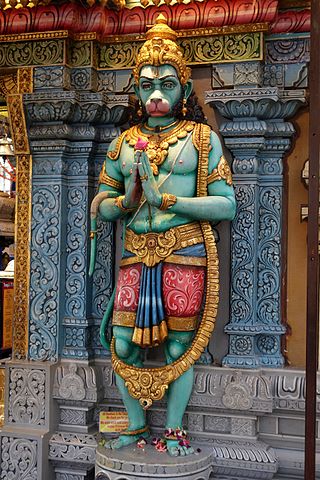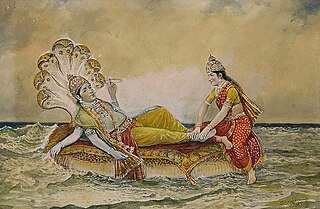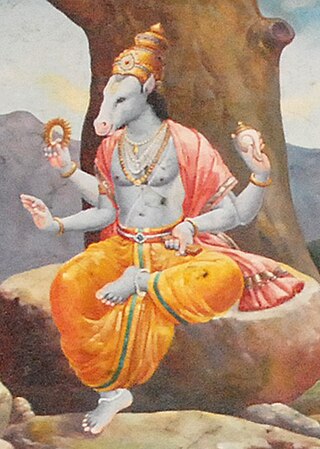Related Research Articles

Vayu, also known as Vata and Pavana, is the Hindu god of the winds as well as the divine messenger of the gods. In the Vedic scriptures, Vayu is an important deity and is closely associated with Indra, the king of gods. He is mentioned to be born from the breath of Supreme Being Vishvapurusha and also the first one to drink Soma. The Upanishads praise him as Prana or 'life breath of the world'. In the later Hindu scriptures, he is described as a dikpala, who looks over the north-west direction. The Hindu epics describe him as the father of the god Hanuman and Bhima.

Krishna Dvaipayana, better known as Vyasa or Veda Vyasa, is a revered rishi (sage) portrayed in most Hindu traditions. He is traditionally regarded as the author of a number of Hindu texts, including the epic Mahābhārata.

The Chiranjivi are a group of immortals who are believed to remain alive on Earth until the end of the current age known as the Kali Yuga, according to Hindu literature.

Madhvacharya, also known as Purna Prajna and Ānanda Tīrtha, was an Indian philosopher, theologian and the chief proponent of the Dvaita (dualism) school of Vedanta. Madhva called his philosophy Tattvavāda meaning "arguments from a realist viewpoint".

Narayana is one of the forms and epithets of Vishnu. In this form, the deity is depicted in yogic slumber under the celestial waters, symbolising the masculine principle and associated with his role of creation. He is also known as Purushottama, and is considered the Supreme Being in Vaishnavism.

Hayagriva is a Hindu deity, the horse-headed avatar of Vishnu. The purpose of this incarnation was to slay a danava also named Hayagriva, who had the neck of a horse and the body of a human.
Parashara was a maharishi and the author of many ancient Indian texts. He is accredited as the author of the first Purana, the Vishnu Purana, before his son Vyasa wrote it in its present form. He was the grandson of the sage Vasishtha and the son of the sage Shakti. There are several texts which give reference to Parashara as an author/speaker. The various texts attributed to him are given in reference to Parashara being the speaker to his student.

The Harivamsa is an important work of Sanskrit literature, containing 16,374 shlokas, mostly in the anustubh metre. The text is also known as the Harivamsa Purana. This text is believed to be a khila to the Mahabharata and is traditionally ascribed to Vyasa. The most celebrated commentary of the Mahabharata by Neelakantha Chaturdhara, the Bharata Bhava Deepa also covers the Harivamsa. According to a traditional version of the Mahabharata, the Harivamsa is divided into two parvas (books) and 12,000 verses. These are included with the eighteen parvas of the Mahabharata. The Critical Edition has three parvas and 5,965 verses.
Pulastya is one of the ten Prajapati, and one of the mind-born sons of Brahma in Hinduism. He is also one of the Saptarishi in the first age of Manu, the Manvantara.

The Kumaras are four sages (rishis) from the Puranic texts of Hinduism who roam the universe as children, generally named Sanaka, Sanandana, Sanatana, and Sanatkumara. They are described as the first mind-born creations and sons of the creator-god Brahma. Born from Brahma's mind, the four Kumaras undertook lifelong vows of celibacy (brahmacharya) against the wishes of their father. They are said to wander throughout the materialistic and spiritualistic universe without any desire but with the purpose of teaching. All four brothers studied Vedas from their childhood, and always travelled together.

Bannanje Govindacharya was an Indian philosopher and Sanskrit scholar versed in Veda Bhashya, Upanishad Bhashya, Mahabharata, Puranas and Ramayana. He wrote Bhashyas (commentaries) on Veda Suktas, Upanishads, Shata Rudriya, Brahma Sutra Bhashya, Gita Bhashya and was an orator. He was awarded the Padma Shri by the Government of India in 2009.
Sri Narayana Panditacharya, is an Indian scholar and philosopher in the Dvaita Vedānta tradition. He was the youngest son of Trivikrama Panditacharya, one of the direct disciples of Sri Madhva He is the author of Sri Madhva Vijaya, a metrical biography of the rejuvenator of the Dvaita school of philosophy, Sri Madhvacharya. Indologist B. N. K. Sharma writes, "Narayana has earned a lasting fame for himself by his great metrical biography of Madhva".
Over the years, there have been many philosophers, writers and other literary figures who have contributed to the Dvaita school of thought, founded by Sri Madhvacharya.

The Devi Bhagavata Purana, also known as the Srimad Bhagavatam or simply Devi Bhagavatam, is one of the eighteen Mahapuranas of Hinduism. Composed in Sanskrit by Veda Vyasa, the text is considered a major purana for Devi worshippers (Shaktas). It promotes bhakti (devotion) towards Mahadevi, integrating themes from the Shaktadvaitavada tradition. While this is generally regarded as a Shakta Purana, some scholars such as Dowson have also interpreted this Purana as a Shaiva Purana.

Sat Vaishnavism, also referred to as Madhva Vaishnavism, the Madhva Sampradaya and the Brahma Sampradaya, is a denomination within the Vaishnavism—Bhagavata tradition of Hinduism. Sadh Vaishnavism was founded by thirteenth century philosopher-saint Madhvacharya, who developed the Tattvavada (dvaita) Vedanta sub-school of Hindu philosophy.

Satyanatha Tirtha ; IAST:Śrī Satyanātha Tīrtha), also called Abhinava Vyasaraja, was a Hindu philosopher, scholar, theologian, logician and dialectician belonging to the Dvaita order of Vedanta. He served as the twentieth pontiff of Uttaradi Math from 1660 to 1673. He was a fiery and prolific writer and very ambitious of the glory of Dvaita Vedanta. He is considered to be one of the stalwarts in the history of the Dvaita school of thought, on account of his sound elucidations of the works of Madhvacharya, Jayatirtha and Vyasatirtha. Three of his polemically themed doxographical works are reminiscent of "Vyasatraya". His refutation work Abhinava Gada is a devastating criticism of Appayya's Madhvamathamukhamardhana. His independent treatise Abhinava Chandrika is considered a brilliant work relating to the Brahma Sūtras, being a commentary on Jayatirtha's Tattvaprakashika. His work Abhinava Tarka Tandava refuted the works of rival systems, especially those of Prabhākara of Mimamsa, Ramanuja's Visistadvaita, and Gangesha Upadhyaya, Raghunatha Siromani of the Nyaya school, on the same lines as Vyasatirtha's Tarka Tandava. Indologist B.N.K.Sharma wrote, "His energy and determination to crush out the rivalry of Monism is reflected even in the choice of the titles of some of his works, four of which go by the name "Paraśus" ".

Satyabhinava Tirtha was a Hindu philosopher, scholar, theologian and saint. He served as the pontiff of Shri Uttaradi Math from 1673 to 1706. He was the 21st in succession from Madhvacharya. He is known for his great works Durghata Bhavadipa on Bhagavata Tatparya Nirnaya and Mahabharata Tatparya Nirnaya Vyakhyana, a commentary on Mahabharata Tatparya Nirnaya of Madhva.

Krishnacharya Tamanacharya Pandurangi, also known by the pen name Viswamangala, was an Indian Sanskrit scholar and a notable Indologist. Pandurangi was unique among contemporary Sanskrit scholars, being simultaneously at home among both traditional and modern systems of education. In 1989, the Government of India honoured him with the Rashtrapati Award for his contributions to literature and research.
In Hinduism, Śāstra pramāṇam refers to the authority of the scriptures with regard to puruṣārtha, the objects of human pursuit, namely dharma, artha, kāma (pleasure) and mokṣa (liberation). Together with smṛti, ācāra, and ātmatuṣṭi, it provides pramana and sources of dharma, as expressed in Classical Hindu law, philosophy, rituals and customs.
References
- ↑ Steven Rosen (2007). Krishna's Song: A New Look at the Bhagavad Gita. Greenwood Publishing Group. p. 38. ISBN 9780313345531.
- ↑ Vasudeva Rao (2002). Living Traditions in Contemporary Contexts: The Madhva Matha of Udupi. Orient Blackswan. p. 104. ISBN 9788125022978.
- ↑ MBTN - Table of Contents
- ↑ Tattvāloka, Volume 23. Sri Abhinava Vidyatheertha Educational Trust. 2000. p. 33.
- ↑ Page 5 of the Roman transliteration of the MBTN
- ↑ Mahabharata Tatparya Nirnaya Bhava Sangraha
